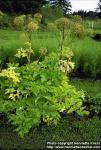2.36 Angelica.
 Latin name: Angelica archangelica
Latin name: Angelica archangelica
2.36.1 Growing Angelica
From: nmm1.cam.ac.uk (Nick Maclaren):
This is a broad-leaved, monocarpic biennial or perennial (i.e. it takes 2-5 years to flower, and then dies) 6-10' high. It likes half shade (to reduce the grass cover), and damp, rich soil. Given the right environment, it will self seed and keep itself established. If you have a very hot, dry garden, don't bother with it. It looks very much like lovage, but smells entirely different.
From HeK:
If you keep the flowerstalk down (break it off every time you see it emerge) the plant will be perennial - until it does flower.
2.36.2 Harvesting angelica
From: nmm1.cam.ac.uk (Nick Maclaren):
Cut the side-shoots (which can be quite thick stems) before they become stringy - this is in May or June in the UK, and is just as the flower heads start to open. You can also cut the flower shoots off a little earlier, which will have the effect of keeping the plant alive for a year or so longer, but it will die after about 5 years anyway.
2.36.3 Using / preserving angelica
Candied angelica stems
From: nmm1.cam.ac.uk (Nick Maclaren):
Cut the shoots into strips about 6" long and ½" wide, and remove untidy bits. Blanch them (i.e. bring them to the boil and throw away the water). Then candy them, using gradually increasing strengths of sugar syrup. When they are done, dry them and keep them, but don't throw away the syrup; it keeps for at least a year in the refrigerator and for a long time just in a jar.
They can be used for decoration, in fruit salad, in ice cream and so on.
The syrup can be used for sweetening such things, and adds a strong angelica taste. I recommend angelica ice cream, made with the chopped stems, syrup and Chartreuse (an angelica-based liqueur) - this recipe is my own invention, incidentally, and this is the first publication :-)
The young leaves and stems are also naturally sweet, and can be used in stewed fruits or other puddings, or used in pot pourris.
Home Candied Angelica
From af961.james.freenet.hamilton.on.ca (Helen Peagram), quoting Philippa Davenport in "Country Living" (British), May 1987.
1 lb Angelica
1 lb Granulated sugar
The most important thing about candying angelica is to choose stalks that are young and tender. In other words, angelica is only worth candying in April or May when the shoots are new and softly coloured. Trim the young shoots into 3-4 inch lengths, put them into a pan, cover with water and bring to a boil. Drain and scrape away tough skin and fibrous threads with a potato peeler, rather as you might prepare celery. Return the angelica to the pan, pour on fresh boiling water and cook until green and tender. If the shoots are as youthful as they should be, this will take 5 minutes or less. Drain the stalks and dry them. Put them into a bowl and sprinkle granulated sugar between layers, allowing 1 pound of sugar for every 1 pound of angelica.
Cover and leave for 2 to 3 days.
Slide contents of the bowl into a heavy-based pan. Bring very slowly to the boil and simmer until the angelica feels perfectly tender and looks clear. Drain, then roll or toss the shoots on greaseproof paper thickly strewn with sugar, letting the angelica take up as much sugar as will stick to it. Then dry off the angelica - without letting it become hard - in the oven, using the lowest possible temperature. I place the stalks directly on the oven shelves (with trays underneath to catch any falling sugar) and find they need about 3 hours. Wrap and store after cooling completely. Packed into pretty little boxes, home-candied angelica makes a charming present.
Angelica stem survey:
Have you eaten candied angelica stems? Did you like it? Would you eat them again? Answers to the survey, so far:
- From Ingolfur Guðnason <engiherb.smart.is>:
Since you are asking: yes, I have tried to make candied angelica from young leaf stalks. It is very nice. I keep a jar in my refrigerator and serve it to guests as a curiosity.
In the times of the Vikings candied angelica was in very high esteem, sold as a candy in the streets of Norway and British Isles etc. - From Francoise Chevallier Allard <fcallard.univ-lyon1.fr>:
It is commonly used for cakes in central Europe, and in Italy for icecreams. I think it is nice, but perhaps a little strong. - From "Mike Toop" <miketoop.uniserve.com>
I just made candied angelica (A. archangelica) for the first time. It has... an interesting flavour. I would try it again. In fact, I'm willing to try just about anything to use up the stuff... it is growing like crazy in my garden! - From david.inf.rl.ac.uk (David Johnston)
Yes, I have eaten Candied angelica stems. When I was small, my mother would decorate the top of an iced cake using angelica and glace' cherries. The combination of the red and green detail on a ground of white icing is very attractive visually. The trick was to cut the (expensive) candied stems into thin slices to make it go further.
When I'd grown up, I bought some candied angelica for my own larder, and permitted myself a taste in isolation. The taste is superb, and memories from my childhood flooded back! I would eat candied angelica all the time if it wasn't so expensive. As a result, I've been trying to grow angelica for about 10 years. Finally, last year a seed germinated and now I'm attempting to candy the stem. That is why I looked up the FAQ! - From "Duane Harding" <hardid.calmvs.ercb.gov.ab.ca>
My dad use to buy it in New York City in the early 1970's. We used it to flavour Christmas pudding.

